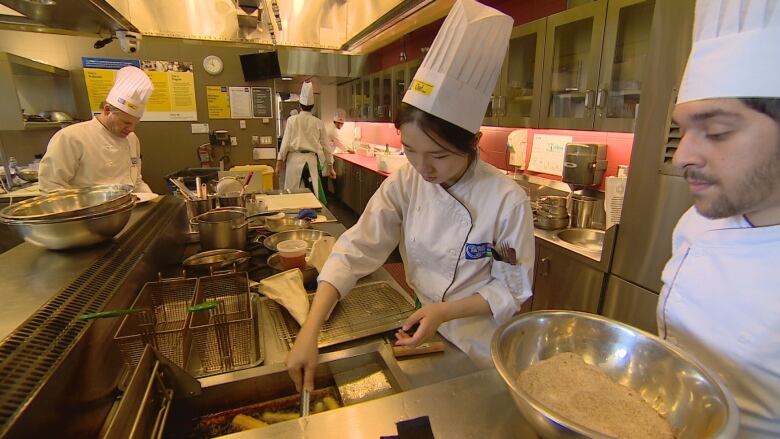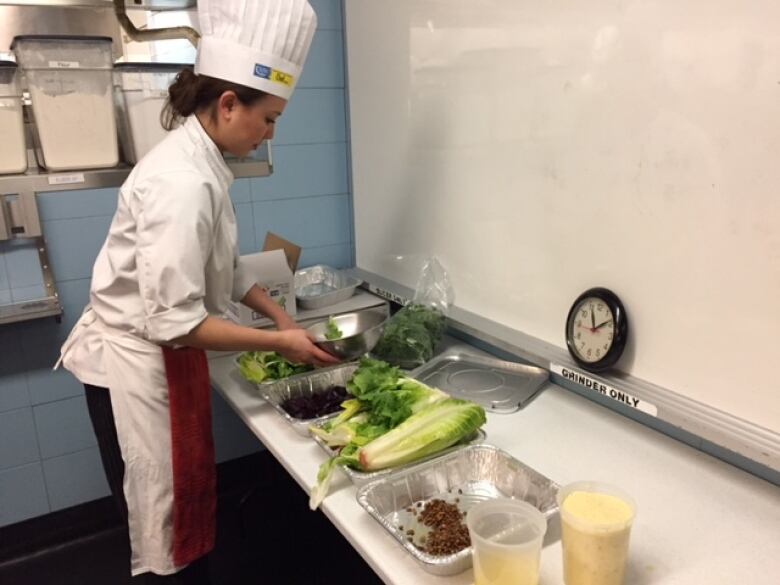Culinary school curbs waste with student food bank
Aspiring chefs help feed fellow students

With food prices expected to rise this year, getting your daily dose of fruits and vegetables can be challenging, especially if you're on a student budget.
George Brown College's culinary program is reducing food waste and making nutritious meals more attainable by donating untouched chef creations to the school's student food bank.
The idea was launched by Jason Inniss, a chef and professor at George Brown, who was put off after seeing so many delectable creations end up in the trash.
"I walked into a classroom one day and found that there was a lot of cooked, good food that was going into the garbage," Inniss told CBC Toronto in an interview.
-
'Astronomical' amount of food could be going to food banks, says farmer
-
OPINION: That 'ugly' grocery store vegetable or fruit deserves love too
Culinary students at George Brown whip upseveral courses daily, including dessert everything from chicken wrapped in serrano ham to gourmet salads andchurrios drizzled with homemade caramel sauce.
Each recipe serves four people. One plate is tasted and graded by the professor, leaving the student with three portions.

"The [culinary] students can eat what they make or take it home, but they just weren't doing it," said Inniss.
After asking around he found that some students were full from a day in the kitchen and others weren't able to take the food with them.
"I have a 50 minute ride to get home and then a 20 minute walk," said second-year culinary student Ryan Graham. "So the food just wouldn't be as good as it is here."
That's when Inniss decided to give the food to thosewho can't afford nutritious meals.
"We wanted to make sure our students are food secure," said Inniss.
The food waste reduction program started in May 2016 in partnership with the school's student association.
All donated food is packaged in single or family-sized portions and sent to the school's food bank, where students can pick up restaurant-quality meals.

So far, about 850 students have signed up for the food bank.
The student association keeps their identities a secretto prevent any type of stigma associated with food banks.
The food bankalso receives donations of uncooked food every few days, but Inniss'sstudents provide all of the cooked meals.
So far, theprogram has given out 1,600 cooked meals.
"If I were in that situation, I would love to have that opportunity. It's not bad food, it's not McDonald's. It's fresh and healthy," said Graham, the culinary student.
"You could end up wasting a lot of food in the kitchen," said second-year student Lindsay Bourgeons. "It's better to give it to those who need it."
With Canadians throwing out an estimated $31 billion worth of food a year, Inniss says the college is doing its part to reduce waste.
"It's not just food that's going into the landfill," said Inniss. "It's the water that goes into growingit;it's the farmer's time, it's the travel, it's the carbon footprint. We're just trying to respect all of that."













_(720p).jpg)


 OFFICIAL HD MUSIC VIDEO.jpg)
.jpg)



























































































